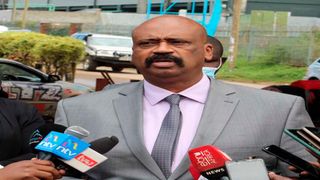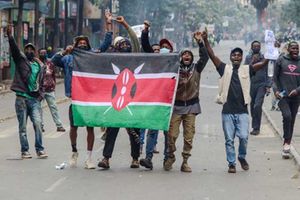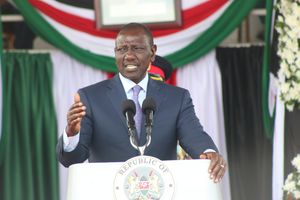
Nairobi Metropolitan Services boss Major General Mohammed Badi.
| File | Nation Media GroupNairobi
Premium
Has NMS lost its development spark?
When Nairobi Metropolitan Services was created in March 2020, it took to rolling out development projects in the city like a duck to water.
Within six months, the Lt-Gen Mohamed Badi’s administration managed to leave a mark around the capital, especially the city centre.
In the transport sector, non-motorised transport corridors had been set up along Kenyatta Avenue and on Wabera and Muindi Mbingu streets.
Traffic signals were also rehabilitated in the central business district, the Community area, Gikomba, Muthurwa, Kirinyaga Road, the Murang’a Road matatu terminus and Kenyatta National Hospital.
Construction of Grogan Road at the Racecourse and Globe roundabout was almost complete, with most roads in the city centre having also been re-carpeted.
The non-motorised transport corridor on Kenyatta Avenue in Nairobi's CBD on Wednesday, March 31, 2021, after it was upgraded by Nairobi Metropolitan Services (NMS).
A backlog of 4,400 development applications had been cleared, Pangani estate renewal commenced, neglected Michuki Park rehabilitated to a botanical garden and recreational park, 93 boreholes across different informal settlements, more than 16,880 lanterns and 2,021 floodlights restored and garbage collection enhanced from 1,000 tonnes a day to 2,500.
Things were working at lightning speed. An asphalt plant on Kangundo Road would be revived, 83 faulty Nairobi County government vehicles restored with another 74 earmarked for rehabilitation.
In the following six months, 100 more boreholes would be drilled across Nairobi, construction of 19 new Levels 2 and 3 hospitals would begin, along with embarking on more road projects.
NMS would be given billions of shillings to help it run the four functions of health, transport, public works, utilities and ancillary services, and county planning and development services taken from the county government.
Treasury Cabinet Secretary Ukur Yatani would allocate NMS more than Sh26 billion for its operations in the financial year to June 30, 2021.
The Nairobi County Assembly would enhance the figure to Sh27.1 billion, with Sh18 billion for recurrent expenditure and a further Sh9.1 billion for development expenditure.
Boosted by the huge financial outlays, NMS would pledge to launch monthly cleanup exercises in October 2020, and set up a sanitary landfill in Ruai to help decongest the already filled Dandora dumpsite, among other promises.
Come 2021, Lt-Gen Badi would set his sights on leaving behind a smart city as his legacy at the end of the 24-month agreement.
The plan would see the introduction of smart lights, smart cameras, underground automated parking as well as digital parks and open spaces to transform the capital into a smart city.
Have not commenced at all
The Nairobi River Waterfront Improvement project was also revived to modernise the front of the river, complete with public resting places and restaurants for use by people.
“We will light up the whole Nairobi River to have people enjoy the river’s front as it is in other cities like the River Thames in London. The restaurants will offer people the chance to talk as they enjoy their evening meals,” said Mr Badi in an interview to mark the one-year anniversary of NMS.
But most of the projects have either hit a dead end, have not commenced at all, are proceeding at a snail’s pace or are threatening to be white elephants.
The plan to move matatus and boda bodas out of the city centre into seven terminals on the outskirts of the city centre is still just a plan.
The Green Park terminus at the former Railways Club, which was to serve as the inaugural stage, is yet to be launched.

PSV vehicles and passengers at Green Park Terminus in Nairobi during the third Nairobi Metropolitan Services test run on June 18, 2021.
Desai and Park Road were completed a long time ago but have not been commissioned. For the remaining four, only work on the Bunyala-Workshop road is underway.
Mathare-Korogocho Level 5 Hospital is yet to be launched; a plan to purchase land for a new cemetery to relieve pressure on the already full Lang’ata cemetery; the renewal and redevelopment of 10 county government estates, including Bahati, Maringo, Jericho, Lumumba, Bondeni, Ziwani, Embakasi, California, Kariobangi North and Woodley, are yet to kick off.
The same can be said of the plan to convert the Machakos Country Bus into an underground parking bay.
In the current financial year ending June 30, 2022, NMS was allocated Sh27.2 billion to support the performance of four transferred county functions.
“I want to see change in Nairobi and I will achieve it in the two years. Come this December, you will see a new Nairobi that will be lit just like Dubai,” Mr Badi said earlier this year. The jury is still out.
Woodley MCA Mwangi Njihia says it could be dawning on NMS that their term is coming to an end and this should have knocked them off their feet.
Used to do a lot of work
He also says that it could also be due to political interference or complacent thinking.
“Those two issues could be the problem leading to the slow pace of development currently being witnessed,” said Mr Njihia.
Nairobi County Assembly Minority Leader Michael Ogada agreed with Mr Njihia’s sentiments, saying: “I would also like them to tell us what the problem is. They used to do a lot of work but now it seems they are in a comfort zone.”
Nairobi County Assembly Minority Leader Michael Ogada.
Former Assembly Speaker Beatrice Elachi opines that the general malaise in NMS could be due to inadequate resources or cartels invading the national government entity.
She agrees that Mr Badi began well but something slowed him down.
“When he started everyone could feel change was happening. I don’t know what is happening now. I have been waiting for matatus to start using the Green Park terminus for months. I don’t know if it is about resources. I need to see other new things,” avers the Gender chief administrative secretary.

“I fear for the general because most of the people who came with him after being seconded have now gone back. Those were the ones who were vibrant,” she says.
“NMS has now gone back to the same team who used to work with (ousted governor Mike) Sonko. Most City Hall officials are the ones who have taken over most of the work. These people can bring you down. They are used to that.”
However, Minority Whip Peter Imwatok defended the slow pace of development, saying NMS has ongoing projects that they are focusing on before launching new ones.
“I cannot rate NMS in terms of launching or initiating new projects. I am keen on completion of projects. There is no need to launch more projects yet others are still hanging. NMS is programmed,” he states.

Minority Whip and Makongeni MCA Peter Imwatok.
But Roselyne Asena, a Nairobi resident, says NMS has lost the verve and consistency it had in 2020 when it came in.
She points out that they used to see projects being completed in under a month before being commissioned and another one launched but this is no more.
“For instance, there are some roads that were marked here in Mukuru with people’s houses being demolished but it has been months with no tangible work going on.”
Nation.Africa reached out to NMS for comment but we did not receive any response.





